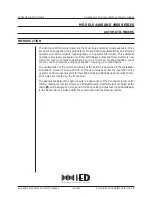
All features & specifications subject to change without notice. 520-214 1193
Printed in the U.S.A. on Recycled Paper
©Rane Corporation 10802 47th Avenue West, Mukilteo WA 98275-5098 TEL(206) 355-6000 FAX(206) 347-7757
OPERATING INSTRUCTIONS
The FMI 14 has been designed to operate in a very
similar fashion to most mixer input strips. The input GAIN
control, PAD, Overload indicator and PHANTOM POWER
selector have all been placed at the top (in the vertical
mounting configuration). Next down the line comes the EQ
section, then the AUX source selectors and level controls,
and finally the MASTER faders. Anyone familiar with
mixers should have no difficulty mastering the FMI 14.
INPUT SECTION.
When setting up the input section,
one should always take as much gain as possible right at the
input. Therefore, the highest level audio from the MIC or
LINE INPUT should just about light the Overload light. It is
good idea to experiment with different gain settings to make
sure the input stage is properly set. Failure to do so will
sacrifice noise performance down the line.
EQUALIZER.
The EQ section of the FMI 14 is particu-
larly interesting. The high frequency and low frequency
shelving tone controls feature Rane’s patented Accelerated
Slope™ circuitry. This helps eliminate the unwanted
influence over out-of-band signals so prevalent in standard
shelving controls. What this means is that the rolloff rates
are much steeper than those usually encountered.
The midrange section of the FMI 14s equalizer is
parametric. The bandwidth may be set to one of three
settings: 1/3 octave, 1 octave, or 2 octaves. The center
frequency may be adjusted over a range of 95Hz to 4kHz.
All three bands cover an amplitude range of -15dB to
+12dB. All of the level controls feature a grounded center
detent thus ensuring that a “zero” setting gives you just what
you wanted: a guaranteed zero (flat).
The EQ IN/OUT switch provides a “hard-wire” bypass
around the equalizer section. Even though the center detents
of the EQ level controls provide a guaranteed zero, some
engineers use the bypass to compare the EQ setting with the
dry non-EQ without changing settings.
AUX SENDS.
The AUX Outputs of the FMI 14 feature
both direct outputs on the rear as well as AUX BUS Outputs
to be combined with other Aux Outputs from other FMI 14s
or Flex mixer units. The source of the AUX Outputs are
switch selectable. They may be driven directly from the
input stage in the PRE EQ position, from the output of the
equalizer in the PRE FD position or from the outputs of the
MASTER A and B faders in the PST FD position.
MASTER OUTPUTS.
The MASTER Outputs also
feature direct, balanced outputs on the rear of the FMI 14 as
well as BUS Outputs for combination with other Flex Bused
modules. The Bus Outputs are normally eventually termi-
nated with a Rane FMM 42 Master Module which can mix
Masters and Auxes into a final stereo output. In this combi-
nation a complete audio mixer may be assembled. When
Busing two FMI 14s or other Flex mixer modules together
without an FMM 42, the ¼" MASTER OUTPUTS of the last
module in the “chain” contain the sum of all previous Master
levels. The ¼" AUX OUTPUTS do not contain the sum.
BUS INS AND OUTS.
The FLEX BUS standard dictates
the use of 7-pin connectors. This may seem strange since the
FMI 14 only uses 5 of them, 2 for Aux, 2 for Master and 1
for ground. There are other possible Flex modules which
may use the other two pins in the future. Should this occur,
the FMI 14 and all other modules not using the 2 spares will
be compatible. The BUS IN and OUT connectors pass the 2
unused connections straight through from Input to Output
thus ensuring their compatibility.
CHASSIS GROUNDING
Rane commercial equalizers are supplied with a rear
mounted ground-lift switch. The unit is shipped with this
switch in the “grounded” position, tying circuit ground
to chassis ground. If after hooking up your system it
exhibits excessive hum or buzzing, there is an incompat-
ibility in the grounding configuration between units
somewhere. Your mission, should you accept it, is to
discover how your particular system wants to be
grounded. Here are some things to try:
1. Try combinations of lifting grounds on units that
are supplied with ground lift switches or links.
2. If your equipment is in a rack, verify that all
chassis are tied to a good earth ground, either through
the line cord grounding pin or the rack screws to another
grounded chassis.
3. Units with outboard power supplies do NOT
ground the chassis through the line cord. Make sure that
these units are grounded either to another chassis which
is earth grounded, or directly to the grounding screw on
an AC outlet cover by means of a wire connected to a
screw on the chassis with a star washer to guarantee
proper contact.
Please refer to Rane Note 110 (supplied with your
unit and available on request at no charge if you lose it)
for further information on system grounding.
IMPORTANT NOTE






















